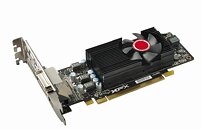Tuesday, November 23rd 2021

AMD Readies Radeon RX 6500 XT and RX 6400 Graphics Cards
AMD is preparing to wrap up its Radeon RX 6000 series desktop discrete graphics card family with two new SKUs, the RX 6500 XT and the RX 6400. The two debut the company's smallest piece of silicon based on the RDNA2 graphics architecture, codenamed "Navi 24," to the desktop space. The RX 6500 XT maxes out this silicon, enabling all 16 compute units physically present, working out to 1,024 stream processors. The RX 6400 is significantly cut down, featuring 12 out of 16 CUs, which means 768 stream processors.
The Navi 24 silicon features a 64-bit wide GDDR6 memory interface, which is paired with 4 GB of discrete memory on both SKUs. This memory operates at 14 Gbps data-rate, which works out to 112 GB/s memory bandwidth. Interestingly, the Infinity Cache makes a comeback, in the form of a tiny 16 MB on-die cache that cushions the memory sub-system. The RX 6500 XT could have just enough muscle for e-sports gaming at 1080p, while the RX 6400 seems more like a card you'd buy just because your processor lacks integrated graphics (eg: if you're using a Ryzen 5000X processor and just need a graphics solution that meets the latest display I/O and media-acceleration standards). At this point we don't know if the Navi 24 is DirectX 12 Ultimate compliant, i.e., featuring Ray Accelerators on its compute units. Both cards are expected to launch in Q1, 2022.
Source:
VideoCardz
The Navi 24 silicon features a 64-bit wide GDDR6 memory interface, which is paired with 4 GB of discrete memory on both SKUs. This memory operates at 14 Gbps data-rate, which works out to 112 GB/s memory bandwidth. Interestingly, the Infinity Cache makes a comeback, in the form of a tiny 16 MB on-die cache that cushions the memory sub-system. The RX 6500 XT could have just enough muscle for e-sports gaming at 1080p, while the RX 6400 seems more like a card you'd buy just because your processor lacks integrated graphics (eg: if you're using a Ryzen 5000X processor and just need a graphics solution that meets the latest display I/O and media-acceleration standards). At this point we don't know if the Navi 24 is DirectX 12 Ultimate compliant, i.e., featuring Ray Accelerators on its compute units. Both cards are expected to launch in Q1, 2022.

68 Comments on AMD Readies Radeon RX 6500 XT and RX 6400 Graphics Cards
Similarly, the RX 6600 has 28 CUs to the XT's 32 (87.5%), 8.9TF vs. 10.6 (83%, so it clocks a bit lower), the same bus width at 128-bit, the same IC at 32MB, and delivers 85% of the performance. The RX 5600 XT vs. the 5700 XT had 36 CUs vs. 40 (90%), 7.2TF vs. 9.8 (73%, so clocked quite a bit lower), a 192-bit bus vs. 256-bit (75%) yet delivered 82% of the performance. Some times these things seem to scale linearly, some times they don't at all. Thus, calculations like these are - at best - very rough estimates and should be treated as such.Yep, sorry about that.That's entirely possible, but the addition of IC has undoubtedly changed that in some way - not to mention AMD's consistent driver development work over the past few years. They might be held back slightly more, but ultimately these GPUs will be more limited by their compute capabilities than anything else. And, being compute limited, stepping down to a non-ultra quality setting is the smart thing to do anyway, as ultra is always wasteful and way past the point of diminishing returns in terms of perceptible quality increases.
IMO, this is a non-issue.That's .... questionable. Even with worst-case-scenario scaling of the 6500 XT being exactly half of a 6600 XT, that GPU delivers an average of 133FPS across TPU's test suite. Half of that would then be 66,5FPS. Of course that average includes games that aren't hitting much higher than 60FPS, which again would then be barely passing 30FPS - but this is at ultra settings on an entry-level GPU. The 6400 is of course further cut down from this, but cut-down GPUs always make more of their compute resources than their fully enabled siblings. 1080p60 at high or mid-high even in current demanding AAA titles should be perfectly doable.
Also, you seem to have missed the point: my argument was that scaling cannot reliably be predicted, period. The drop-off from the high end is typically less than linear with shader resources, but it is crucially not linear at all, but unpredictable and complex. That the end result in performance neither aligns with any spec nor some simple averaging of these is precisely my point. Your argument started from an assumption of linear scaling with compute resources and bandwidth, which might be true, but typically isn't, and is thus a bad assumption to start with.
(Nothing HUGE, but it'd be there)
Seriously, how can anyone get excited for this 64 bit 4 GB pos? Nvidia's 3050 is rumored to be 8 GB (likely 128 bit). Infinity cache will not make up for that 2x bandwidth deficit.
We are about to get RX 480 price and performance 5 years later.
- 6 nm production which could mean great availability
- 107W for 6500 XT :( and 53W for 6400 :love:
- 6400 OEM only :(
- 6500 XT launches at 19. january
@Valantar: your thoughts?
Hopefully they use an 8pin at least (6 pin or 6+2 where you're left with 2 pins hanging out sucks!) but I doubt it
It's a lot nicer than the 300-350W i deal with